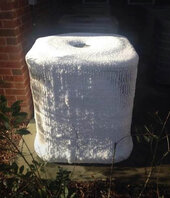Partimewages
Solar Addict
I guess I'm not seeing the point of this. Ground source heat pumps use the water through the refrigeration process to extract or reject heat.45 does not seem worth the effort but possibly worth a try to satisfy the curiosity.
Pump the water through a radiator mounted next to the heat pump with a moderate enclosure so the air drawn in pulls through the radiator first.
There are all kinds of problems with trying to cool/heat an air source coil with water. You likely won't make it through 2 seasons.




